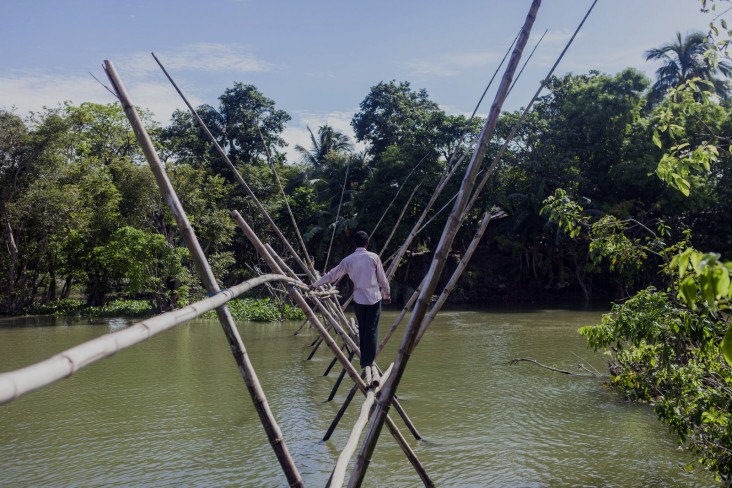Speeches Shim

With over 165 million people, Bangladesh is one of the most densely populated countries in the world, and one of the most vulnerable to natural hazards. The majority of Bangladeshis rely on the country’s natural resources to supplement their livelihoods, placing tremendous strain on an already heavily degraded environment. Frequent natural disasters, significantly diminished ecological services, and an ever-increasing energy demand are key challenges facing Bangladesh as it transitions to a middle-income country. USAID works with the Government of Bangladesh to build resilience of individuals, communities, institutions, and the economy to the impacts of natural hazards and changing climatic conditions. USAID’s assistance contributes to advancing the U.S. vision for a free and open Indo-Pacific.
Improving Management of Natural Resources
Healthy, well-functioning, and biodiverse ecosystems promote long-term sustainability, support poverty alleviation, food and water security, human health, and disaster risk reduction. Improving the sustainability and management of key ecosystems and vital natural infrastructure is essential to reduce poverty and increase Bangladesh’s resilience to a changing climate.
For more than a decade, USAID has helped Bangladesh protect its natural resources and biodiversity by bringing together local communities and the government to form committees that co-manage more than one million hectares of wetlands and forest areas. These community co-management groups monitor protected areas to conserve flora and fauna, prevent illegal poaching, and reduce natural resource degradation. USAID also teaches people living near these protected areas new job skills to generate alternative income sources, directly increasing economic benefits to over 250,000 individuals.
Increasing Resilience to Climate Change Impacts
Two-thirds of Bangladesh has an elevation of five meters or less, which leaves the country vulnerable to devastating natural disasters. Bangladesh is consistently cited as one of the countries in the world most vulnerable to natural disasters, including cyclones, storm surge, floods, earthquakes, and landslides. Long-term impacts from a rise in sea level and global temperature could displace millions of people along Bangladesh’s vulnerable coastline. Improving the country’s resilience to immediate and future climate risks is essential to the continuing development of Bangladesh.
USAID supports training for communities in the most vulnerable areas to become better prepared to mitigate the effects of natural disasters and recover from climatic shocks. These programs have helped establish early warning systems to alert people to flooding and incoming cyclones. USAID has also constructed multi-purpose cyclone shelters to provide a safe haven for communities in the most vulnerable areas of Bangladesh. In addition, USAID provides technical assistance to local governments to promote better use of climate information and analysis in decision-making and become more responsive to the needs of local constituents.
Strengthening Capacity to Reduce Emissions
Bangladesh has made great progress expanding its power trade, production, and distribution network but still fails to meet the nation’s electricity demand. The lack of access and unreliability of supply serves as a constraint on economic development in many parts of Bangladesh. The Government of Bangladesh recognizes the importance of renewable energy production and increased energy efficiency in meeting the country’s energy needs and has set an ambitious target of 10 percent of total energy production from renewable energy resources by 2020. While plans to boost energy production will increase greenhouse gas emission, Bangladesh was the first country to sign a memorandum of understanding with the U.S. Government under the “Enhancing Capacity for Low Emission Development Strategies” initiative. USAID promotes improved efficiency in energy generation, bolsters regulation of emissions, and expands the use of clean and renewable sources of energy, including solar and wind power.
Results
In 2019, USAID programs in Bangladesh:
- Improved community management of 35 village common forests, covering over 2,000 hectares, resulting in fewer natural resource conflicts.
- Partnered with the Bangladesh Forest Department to restore 820 hectares of reserved forest area through natural regeneration techniques.
- Supported Bangladesh’s Daffodil International University through a Partnerships for Enhanced Engagement in Research (PEER) research grant to measure land use and land change, specifically biomass in the coastal mangrove Sundarbans and Sal forests using drone-based photography and computer modeling techniques.
Read the 2016 Bangladesh Tropical Forest and Biodiversity Assessment
Millions of Bangladeshis depend on the Sundarbans, the world's largest mangrove forest, for food, resources, and shelter. See how USAID is working with Bangladesh to protect the forest, its native royal Bengal tigers and other important animal species, and help people living in this area become less reliant on natural resources for food and their livelihood.


Comment
Make a general inquiry or suggest an improvement.